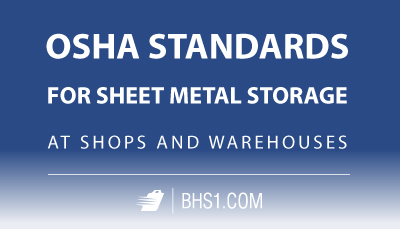We use cookies to make your experience better. To comply with the new e-Privacy directive, we need to ask for your consent to set the cookies. Learn more.
OSHA Standards for Sheet Metal Storage at Shops and Warehouses
Sheet metal isn't always the simplest material to work with, but choosing the right type of storage can set you up for a safer, more successful material handling environment at the shop or warehouse. While the Occupational Safety and Health Administration (OSHA) hasn't written a regulation that refers to sheet metal storage in specific, the standards do offer clues.
Here are the OSHA standards to watch out for, along with a few ways to comply (and build a safer workplace while you're at it):
29 CFR 1910.176(b) - Secure storage
Here, we're deep into the core of the OSHA regulations that affect most industries, including HVAC technicians and other sheet metal workers. Part 1910 of the OSHA regulations covers occupational safety and health for general industry (as opposed to, say, Part 1926, which specifically applies to construction).
Subpart N of the OSHA regulations mandates safety practices for storing and handling materials — including, certainly, sheet metal. Drilling down to this specific standard, 1910.176(b), we learn that: "Storage of material shall not create a hazard."
The standard goes on to suggest that "bags, containers, bundles, etc.," must be stacked so that they won't slide or collapse. Unfortunately, this doesn't necessarily tell us much about sheet metal (although we suspect OSHA lawyers would include it under the purposefully vague designation "etc.")
29 CFR 1926.250(a)(1) - General

It's true that the OSHA standards listed under Part 1926 are written specifically for the construction industry. But in this case, they're also a helpful adjunct to the previous standard. Unlike 1910.176, the guidance on stacking materials doesn't refer specifically to "bags, containers, bundles," or other similarly shaped items.
Instead, it simply reads, "All materials stored in tiers shall be stacked, racked, blocked, interlocked, or otherwise secured to prevent sliding, falling, or collapse."
This suggests that the probable intent in both standards is to prevent sheet metal from "sliding, falling, or collapse."
One way to accomplish this goal is to install Sheet Material Racks fitted with an anti-skid surface. These racks make it easy to store sheet metal securely without the handling difficulties (and excessive footprint) that come with stacking materials flat on the ground. For an even more versatile sheet metal storage solution, choose Mobile Sheet Material Racks.
29 CFR 1910.22 - Surface conditions
The adoption of vertical Sheet Material Racks can also help comply with a few of the specific rules listed under standard 1910.22, which covers walking and working surfaces (floors, essentially). For instance, 1922(a)(1) tells employers to make sure that "all places of employment, passageways, storerooms, service rooms, and walking-working surfaces are kept in a clean, orderly, and sanitary condition."
Flat stacks of sheet metal might not meet this standard. In addition, 1910.22(a)(3) tells employers to ensure "walking-working surfaces are maintained free of hazards such as sharp or protruding objects, loose boards, corrosion, leaks, spills, snow, and ice."
When stored in a haphazard, clumsy fashion, sharp edges of metal sheets can absolutely qualify as a "sharp or protruding" object. Better, then, to simply meet OSHA standards for sheet metal storage by investing in a racking system that fits your precise needs.
References:
"29 CFR 1910.176 - Materials Handling and Storage." OSHA. Occupational Safety and Health Administration, United States Department of Labor, n.d. Web. 19 Mar. 2018.
"29 CFR 1926.250 - Materials Handling, Storage, Use, and Disposal." OSHA. Occupational Safety and Health Administration, United States Department of Labor, n.d. Web. 19 Mar. 2018.
"29 CFR 1910.22 - Walking-Working Surfaces." OSHA. Occupational Safety and Health Administration, United States Department of Labor, n.d. Web. 19 Mar. 2018.
